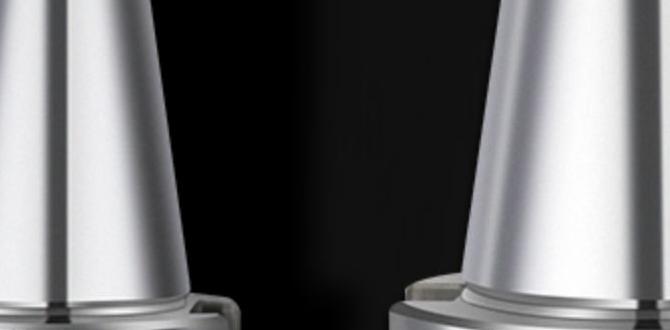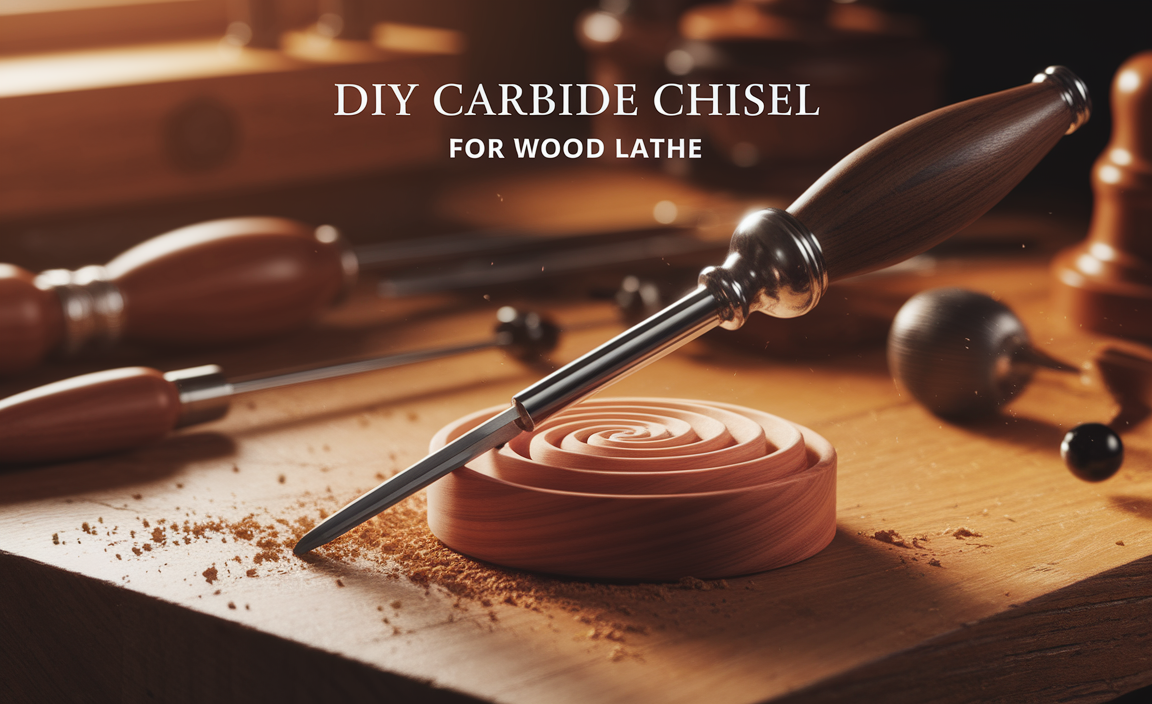A 1/8 inch carbide end mill is a small but mighty tool, crucial for precision cutting in carbon steel. It offers superior hardness and heat resistance, making it ideal for detailed work and tougher materials where standard end mills might struggle.
Working with carbon steel can be tough, and sometimes you need a tool that’s just right for the job. When you’re aiming for fine details or need to cut precisely through harder metals without a fuss, a specific tool makes all the difference. Many beginners find themselves wrestling with materials, getting frustrated when their tools don’t perform as expected. It’s a common roadblock, but the good news is that the right cutting tool can transform your experience. We’re going to walk through exactly why a 1/8 inch carbide end mill is your best friend for carbon steel projects. Get ready to unlock smoother cuts and better results!
Why a 1/8 Inch Carbide End Mill is Your Go-To for Carbon Steel
Carbon steel, loved for its strength and durability, can be a bit demanding to machine. It’s harder than mild steel and can dull or break less robust cutting tools quickly. This is where a carbide end mill shines. Carbide is an incredibly hard material, much harder than high-speed steel (HSS) traditionally used in many cutting tools.
A 1/8 inch carbide end mill, specifically, is perfect for those intricate cuts and smaller features you often find in detailed work. Its small diameter allows for tight tolerances and detailed profiling. When you combine its size with the superior hardness of carbide, you get a tool that can handle carbon steel with authority, offering precise cuts and a much longer lifespan compared to softer materials.
The Advantages of Carbide for Machining Carbon Steel
Carbide isn’t just hard; it also boasts excellent heat resistance. Machining, especially with tougher materials like carbon steel, generates a lot of friction and heat. HSS tools can soften and lose their cutting edge under these conditions, leading to poor surface finish and tool failure. Carbide, on the other hand, can withstand much higher temperatures, allowing you to maintain consistent cutting speeds and achieve cleaner results, even when working with challenging alloys.
Here’s a quick rundown of why carbide is superior for this task:
- Superior Hardness: Stands up to tough materials like carbon steel without easily wearing down.
- Excellent Heat Resistance: Maintains its cutting edge even when high temperatures are generated during machining.
- Increased Rigidity: Less prone to deflection, leading to more accurate cuts.
- Longer Tool Life: When used correctly, carbide tools last significantly longer than HSS tools in demanding applications.
- Better Surface Finish: The hardness and rigidity contribute to smoother, cleaner cuts on the workpiece.
Understanding the 1/8 Inch Shank Size (and Why it Matters)
The “1/8 inch” in “1/8 inch carbide end mill” refers to the diameter of the cutting head. This small diameter is fantastic for detailed work. Think of jewelry making, miniature components, intricate engraving, or creating small pockets and slots in a workpiece. This size allows for very fine detail and precise control.
Coupled with this is the shank size, which is the part of the tool that holds into your milling machine’s collet or tool holder. While this article focuses on the 1/8-inch diameter, you’ll often see variations in shank diameter. A common pairing for a 1/8 inch end mill is a 3/8 inch shank. This larger shank provides more stability and rigidity, especially important when you’re applying cutting forces to carbon steel. A sturdyshank helps prevent chatter and vibration, contributing to a better finish and preventing tool breakage. For example, a tool described as a “carbide end mill 1/8 inch 3/8 shank” tells you it has a 1/8 inch cutting diameter and a 3/8 inch shank, which is a robust combination for many milling tasks.
You might also encounter “extra long” versions of these tools. An extra long end mill allows you to reach deeper into a workpiece or machine features that are further away from your machine’s spindle. When machining carbon steel, the added length can be beneficial, but it also introduces potential challenges like increased tool deflection. It’s a trade-off that needs careful consideration of your setups and cutting parameters.
Dry Cutting vs. Using Coolant
When working with carbon steel and carbide end mills, a common question is whether to use a coolant or to dry cut. The term “dry cutting” means milling without any cutting fluid. Carbide’s excellent heat resistance makes dry cutting a viable option in many scenarios, especially with smaller tools and less demanding cuts, provided you manage chip evacuation well.
However, using a coolant or lubricity can offer significant benefits. Coolant helps to:
- Reduce Heat: This is the primary benefit, extending tool life and preventing thermal shock to both the cutter and the workpiece.
- Improve Chip Evacuation: Coolant can help wash away chips, preventing them from recutting and damaging the surface finish or the tool.
- Reduce Friction: Lubricating the cut can lead to less force required and a smoother operation.
For a 1/8 inch carbide end mill in carbon steel, whether you dry cut or use coolant often depends on your machine’s capabilities, the specific operation, and your desired outcome. For very short, light passes, dry cutting might be sufficient. For longer cuts, deeper slots, or continuous milling operations, a targeted coolant application—even a mist coolant system for smaller machines—can dramatically improve performance and tool longevity. For more information on best practices for machining, the National Institute of Standards and Technology (NIST) offers valuable resources on manufacturing processes.
Choosing the Right 1/8 Inch Carbide End Mill
Not all carbide end mills are created equal. When you’re specifically looking for one for carbon steel, consider these factors:
End Mill Geometry
The geometry of an end mill, such as the number of flutes, the helix angle, and the cutting edge design, plays a big role in its performance.
- Number of Flutes: For carbon steel, end mills with fewer flutes (like 2 or 4) are often preferred. More flutes can pack up with chips, especially in tougher materials, leading to poor chip evacuation and potential tool breakage. Fewer flutes provide better space for chips to escape.
- Helix Angle: A standard helix angle (around 30 degrees) is generally good for a variety of materials, including mild steels. For harder steels or materials that tend to “gum up,” a variable helix or a higher helix angle might offer better cutting action and chip control.
- Coating: Some carbide end mills come with coatings like TiN (Titanium Nitride) or TiAlN (Titanium Aluminum Nitride). These coatings add an extra layer of hardness and can further improve heat resistance and tool life, making them excellent choices for machining carbon steel.
Specific Types to Look For
When searching, you might see terms like:
- Square End Mills: These have a flat tip and are used for cutting slots, profiles, and pockets. This is the most common type.
- Ball Nose End Mills: These have a rounded tip and are used for creating contoured surfaces, 3D shapes, and rounded internal corners.
- Corner Radius End Mills: These are similar to square end mills but have a small radius at the corners. This radius strengthens the cutting edge and helps prevent chipping, which is beneficial for materials like carbon steel.
For general-purpose carbon steel machining with a 1/8 inch size, a 2-flute or 4-flute square end mill with a robust coating is often an excellent starting point.
Setting Up for Success: Key Considerations
Using a 1/8 inch carbide end mill effectively on carbon steel requires careful setup. Even the best tool won’t perform well if your machine setup isn’t right.
Workholding is Crucial
Because you’re dealing with a smaller tool and potentially harder material, ensuring your workpiece is held as securely as possible is paramount. Any movement or vibration can lead to poor surface finish, inaccurate dimensions, or even tool breakage. Use a sturdy vise, clamps, or fixtures that can withstand the cutting forces without flexing.
Tool Holder and Runout
A quality tool holder that minimizes runout (the wobble of the end mill as it spins) is essential. Excessive runout causes uneven cutting, increased tool wear, and chatter. For precise work with small end mills, using a high-quality collet chuck or ER collets can make a big difference. Check your machine’s tooling setup to ensure minimal runout.
Machining Parameters (Speeds and Feeds)
This is where many beginners struggle. Carbon steel requires slower spindle speeds and appropriate feed rates compared to softer metals. Carbide tools can spin faster than HSS, but you still need to be mindful of the material and the tool size.
A general starting point for a 1/8 inch carbide end mill in carbon steel might look something like this:
- Spindle Speed: Around 4,000 – 8,000 RPM, but this can vary greatly depending on the specific steel alloy, coating, and milling operation.
- Feed Rate: This is how fast the tool moves into the material. For a 1/8 inch end mill, a chip load of around 0.001 to 0.002 inches per tooth is a common starting point. This translates to a federate of (chip load per tooth × number of flutes × RPM). For example, with a 2-flute end mill at 6,000 RPM and a chip load of 0.0015 inches per tooth, the federate would be 0.0015 × 2 × 6000 = 18 inches per minute (IPM).
- Depth of Cut: For roughing, try starting with a depth of cut of about 0.010 to 0.020 inches. For finishing passes, a much shallower depth of cut (e.g., 0.005 inches or less) will yield better surface finish.
Important Note: These are starting points. Always consult the end mill manufacturer’s recommendations for speeds and feeds. It’s often best to start conservatively and gradually increase the parameters while observing the cut, listening for any unusual sounds (like chatter), and checking the chip formation and workpiece finish. You can find comprehensive guides on feeds and speeds through resources like the Machinery’s Handbook.
Here’s a simplified table to help visualize these starting points:
| Parameter | Typical Range for 1/8″ Carbide End Mill in Carbon Steel | Notes |
|---|---|---|
| Spindle Speed (RPM) | 4,000 – 8,000 | Adjust based on material hardness, coating, and operation. |
| Chip Load per Tooth (inch/tooth) | 0.001 – 0.002 | Crucial for preventing tool wear and ensuring good chip evacuation. |
| Federate (IPM) | Calculate: (Chip Load × Flutes × RPM) | Varies widely based on the three components of the calculation. |
| Depth of Cut (DOC) – Roughing (inch) | 0.010 – 0.020 | Take lighter cuts to avoid overloading the tool. |
| Depth of Cut (DOC) – Finishing (inch) | ≤ 0.005 | For a smooth surface finish. |
Common Operations Using a 1/8 Inch Carbide End Mill
A 1/8 inch carbide end mill is incredibly versatile for specific tasks in carbon steel:
- Profiling: Cutting out the outer shape of a part. The small diameter allows for very tight curves and sharp internal corners.
- Slotting: Creating narrow slots or grooves. A 1/8 inch end mill is perfect for creating slots of precisely 1/8 inch width.
- Pocketing: Machining out recessed areas in a workpiece.
- Engraving and Detail Work: Its small size makes it ideal for creating fine details, text, or intricate patterns.
- Deburring Corners: Gently breaking sharp edges to improve safety and fit.
Example Project Idea: Custom Machined Fixture Component
Imagine you need to create a small, custom bracket or a specialized insert for a jig. Carbon steel might be chosen for its strength. You could use your 1/8 inch carbide end mill on your milling machine to:
- Precisely cut the outer profile of the bracket.
- Mill out a narrow slot for a bolt or pin.
- Engrave a part number or alignment mark.
This kind of work is where the precision of a 1/8 inch carbide end mill truly lets you shine.
When to Consider Alternatives or Different Sizes
While the 1/8 inch carbide end mill is fantastic, it’s not always the best tool for every carbon steel job:
- For Larger Areas or Roughing: If you need to remove a lot of material quickly, a larger end mill (e.g., 1/4 inch, 1/2 inch) will be more efficient. Using a tiny end mill for bulk material removal is slow and puts undue stress on the tool.
- For Very Deep Cuts: While extra-long end mills exist, the further out the cutting edge is from the spindle, the more likely it is to deflect. For very deep slots, specialized tooling or different machining strategies might be necessary.
- For Extremely Hardened Steel: For steels that have been through hardening and tempering processes to very high Rockwell hardness levels, even carbide might struggle. Specialized tooling, slower speeds, and different techniques might be required.
- Cost: Carbide end mills, especially coated ones, are generally more expensive than HSS. If your budget is very tight and you’re only doing very light work on softer materials, HSS might be considered, but for carbon steel, carbide is usually worth the investment.
Safety First: Always
Machining, especially with rotating tools and harder materials, carries inherent risks. Always prioritize safety:
- Wear Safety Glasses: Always! Even with face shields, flying chips are a hazard.
- Secure Your Workpiece: A loose part can become a dangerous projectile.
- Proper Tool Holding: Ensure the end mill is securely and correctly seated in the collet or holder.
- Keep Hands Clear: Never touch a spinning tool or workpiece.
- Chip Evacuation Management: Understand how chips are being cleared. Jammed chips can cause tool breakage or kickback.
- Emergency Stop: Know where your machine’s emergency stop button is.
- Read Manuals: Familiarize yourself with your milling machine’s operation and safety features.
Following safe practices ensures you can enjoy your machining projects without incidents. Many milling machine manuals provide detailed safety checklists and operating procedures.
Frequently Asked Questions (FAQ)
Q1: Can I use a 1/8 inch carbide end mill for aluminum?
A: Yes, you can, but you’ll need to adjust your speeds and feeds significantly. Aluminum is much softer and “gummier” than carbon steel. You’ll typically run much higher spindle speeds and slower federates, and you’ll likely need a different flute geometry (e.g., high-helix, polished flutes) and definitely a good coolant or lubricant to prevent the aluminum from sticking to the end mill.
Q2: How do I know if my end mill is dull?
A: Signs of a dull end mill include increased chatter (vibration), a rougher surface finish, increased cutting forces (requiring more power), chips that are not well-formed (e.g., feathery rather than small, crispy curls), and the tool getting excessively hot. If you hear a distinct “screaming” or grinding sound, it’s a strong indicator of a dull tool or improper parameters.
Q3: What is the difference between a 2-flute and a 4-flute end mill for carbon steel?
A: For carbon steel, a 2-flute end mill generally provides better chip clearance. Carbon steel produces tougher, stringier chips. The wider flutes of a 2-flute tool allow these chips to exit more easily, preventing chip recutting and reducing the risk of tool breakage. A 4-flute end mill offers a smoother cutting action and can be used for finishing passes or in materials that produce smaller, more brittle chips.
Q4: My 1/8 inch end mill is breaking. What am I doing wrong?
A: This is a common frustration! It could be due to several factors: feeding too fast, taking too deep a cut, insufficient spindle speed (causing rubbing rather than cutting), poor rigidity in your setup (workpiece moving, tool holder runout), or the end mill being dull. For carbon steel, ensure you’re not trying to hog out too much material at once. Take lighter, shallower cuts.





